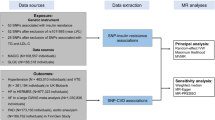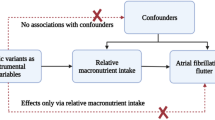Abstract
Fat mass and fat-free mass are found to be associated with different health outcomes in observational studies, but the underlying causality remains unclear. We aimed to investigate the causal relationships between body composition and cardiometabolic traits using a two-sample Mendelian randomization (MR) approach. Independent genetic variants associated with body fat mass, fat-free mass, and fat percentage in UK Biobank population were used as genetic instrumental variables, and their causal effects on circulatory diseases, type 2 diabetes, glycemic traits, and lipid fractions were estimated from large-scale genome-wide association studies (GWAS) in European populations. Univariable, multivariable, and bidirectional MR analyses were performed. Genetically predicted high fat mass and fat percentage significantly increased risks of most cardiometabolic diseases, and high fat-free mass had protective effects on most cardiometabolic diseases after accounting for fat mass. Fat mass, fat-free mass, and fat percentage were all positively associated with higher risks of atrial fibrillation and flutter, varicose veins, and deep vein thrombosis and pulmonary embolism. High fat mass increased fasting glucose, homeostasis model assessment-insulin resistance (HOMA-IR), triglycerides, decreased high-density lipoprotein cholesterol, and high fat-free mass reduced HOMA-IR, triglycerides, and low-density lipoprotein cholesterol. Genetically predicted fat-free mass was bidirectionally negatively associated with 2-h glucose and total cholesterol. The findings may be helpful in risk stratification and tailoring management of body composition in patients with different cardiometabolic statuses.






Similar content being viewed by others
Availability of data and material
Genetic instrumental variables and data sources are presented in Supplementary Tables.
Code availability
Code used to undertake mendelian randomization analyses can be found in the R packages “TwoSampleMR”, “MRPRESSO”, and “cause”.
References
Lee DH, Keum N, Hu FB, Orav EJ, Rimm EB, Willett WC, et al. Comparison of the association of predicted fat mass, body mass index, and other obesity indicators with type 2 diabetes risk: two large prospective studies in US men and women. Eur J Epidemiol. 2018;33(11):1113–23. https://doi.org/10.1007/s10654-018-0433-5.
Son JW, Lee SS, Kim SR, Yoo SJ, Cha BY, Son HY, et al. Low muscle mass and risk of type 2 diabetes in middle-aged and older adults: findings from the KoGES. Diabetologia. 2017;60(5):865–72. https://doi.org/10.1007/s00125-016-4196-9.
Byambasukh O, Eisenga MF, Gansevoort RT, Bakker SJ, Corpeleijn E. Body fat estimates from bioelectrical impedance equations in cardiovascular risk assessment: the PREVEND cohort study. Eur J Prev Cardiol. 2019;26(9):905–16. https://doi.org/10.1177/2047487319833283.
Medina-Inojosa JR, Somers VK, Thomas RJ, Jean N, Jenkins SM, Gomez-Ibarra MA, et al. Association between adiposity and lean mass with long-term cardiovascular events in patients with coronary artery disease: no paradox. J Am Heart Assoc. 2018;7(10): e007505. https://doi.org/10.1161/jaha.117.007505.
Xing Z, Tang L, Chen J, Pei J, Chen P, Fang Z, et al. Association of predicted lean body mass and fat mass with cardiovascular events in patients with type 2 diabetes mellitus. CMAJ. 2019;191(38):E1042–8. https://doi.org/10.1503/cmaj.190124.
Fenger-Grøn M, Overvad K, Tjønneland A, Frost L. Lean body mass is the predominant anthropometric risk factor for atrial fibrillation. J Am Coll Cardiol. 2017;69(20):2488–97. https://doi.org/10.1016/j.jacc.2017.03.558.
Azarbal F, Stefanick ML, Assimes TL, Manson JE, Bea JW, Li W, et al. Lean body mass and risk of incident atrial fibrillation in post-menopausal women. Eur Heart J. 2016;37(20):1606–13. https://doi.org/10.1093/eurheartj/ehv423.
Lawlor DA, Harbord RM, Sterne JA, Timpson N, Davey SG. Mendelian randomization: using genes as instruments for making causal inferences in epidemiology. Stat Med. 2008;27(8):1133–63. https://doi.org/10.1002/sim.3034.
Lyall DM, Celis-Morales C, Ward J, Iliodromiti S, Anderson JJ, Gill JMR, et al. Association of body mass index with cardiometabolic disease in the uk biobank: a mendelian randomization study. JAMA Cardiol. 2017;2(8):882–9. https://doi.org/10.1001/jamacardio.2016.5804.
Richardson TG, Sanderson E, Elsworth B, Tilling K, Davey SG. Use of genetic variation to separate the effects of early and later life adiposity on disease risk: mendelian randomisation study. BMJ. 2020;369: m1203. https://doi.org/10.1136/bmj.m1203.
Wang N, Cheng J, Ning Z, Chen Y, Han B, Li Q, et al. Type 2 diabetes and adiposity induce different lipid profile disorders: a mendelian randomization analysis. J Clin Endocrinol Metab. 2018;103(5):2016–25. https://doi.org/10.1210/jc.2017-02789.
Larsson SC, Bäck M, Rees JMB, Mason AM, Burgess S. Body mass index and body composition in relation to 14 cardiovascular conditions in UK Biobank: a Mendelian randomization study. Eur Heart J. 2020;41(2):221–6. https://doi.org/10.1093/eurheartj/ehz388.
Tikkanen E, Gustafsson S, Knowles JW, Perez M, Burgess S, Ingelsson E. Body composition and atrial fibrillation: a Mendelian randomization study. Eur Heart J. 2019;40(16):1277–82. https://doi.org/10.1093/eurheartj/ehz003.
Yeung CHC, Au Yeung SL, Fong SSM, Schooling CM. Lean mass, grip strength and risk of type 2 diabetes: a bi-directional Mendelian randomisation study. Diabetologia. 2019;62(5):789–99. https://doi.org/10.1007/s00125-019-4826-0.
Shadrina AS, Sharapov SZ, Shashkova TI, Tsepilov YA. Varicose veins of lower extremities: Insights from the first large-scale genetic study. PLoS Genet. 2019;15(4): e1008110. https://doi.org/10.1371/journal.pgen.1008110.
Elsworth B, Lyon M, Alexander T, Liu Y, Matthews P, Hallett J, et al. The MRC IEU OpenGWAS data infrastructure. bioRxiv. 2020:2020.08.10.244293. https://doi.org/10.1101/2020.08.10.244293.
Hemani G, Zheng J, Elsworth B, Wade KH, Haberland V, Baird D, et al. The MR-Base platform supports systematic causal inference across the human phenome. Elife. 2018;7: e34408. https://doi.org/10.7554/eLife.34408.
Pierce BL, Ahsan H, Vanderweele TJ. Power and instrument strength requirements for Mendelian randomization studies using multiple genetic variants. Int J Epidemiol. 2011;40(3):740–52. https://doi.org/10.1093/ije/dyq151.
Zhou W, Nielsen JB, Fritsche LG, Dey R, Gabrielsen ME, Wolford BN, et al. Efficiently controlling for case-control imbalance and sample relatedness in large-scale genetic association studies. Nat Genet. 2018;50(9):1335–41. https://doi.org/10.1038/s41588-018-0184-y.
Morrison J, Knoblauch N, Marcus JH, Stephens M, He X. Mendelian randomization accounting for correlated and uncorrelated pleiotropic effects using genome-wide summary statistics. Nat Genet. 2020;52(7):740–7. https://doi.org/10.1038/s41588-020-0631-4.
Bowden J, Davey Smith G, Haycock PC, Burgess S. Consistent estimation in mendelian randomization with some invalid instruments using a weighted median estimator. Genet Epidemiol. 2016;40(4):304–14. https://doi.org/10.1002/gepi.21965.
Bowden J, Davey Smith G, Burgess S. Mendelian randomization with invalid instruments: effect estimation and bias detection through Egger regression. Int J Epidemiol. 2015;44(2):512–25. https://doi.org/10.1093/ije/dyv080.
Verbanck M, Chen CY, Neale B, Do R. Detection of widespread horizontal pleiotropy in causal relationships inferred from Mendelian randomization between complex traits and diseases. Nat Genet. 2018;50(5):693–8. https://doi.org/10.1038/s41588-018-0099-7.
Burgess S, Thompson SG. Multivariable Mendelian randomization: the use of pleiotropic genetic variants to estimate causal effects. Am J Epidemiol. 2015;181(4):251–60. https://doi.org/10.1093/aje/kwu283.
Larsson SC, Burgess S. Fat mass and fat-free mass in relation to cardiometabolic diseases: a two-sample Mendelian randomization study. J Intern Med. 2020;288(2):260–2. https://doi.org/10.1111/joim.13078.
Tyrovolas S, Panagiotakos D, Georgousopoulou E, Chrysohoou C, Tousoulis D, Haro JM, et al. Skeletal muscle mass in relation to 10 year cardiovascular disease incidence among middle aged and older adults: the ATTICA study. J Epidemiol Commun Health. 2020;74(1):26–31. https://doi.org/10.1136/jech-2019-212268.
Zhang H, Lin S, Gao T, Zhong F, Cai J, Sun Y, et al. Association between sarcopenia and metabolic syndrome in middle-aged and older non-obese adults: a systematic review and meta-analysis. Nutrients. 2018;10(3):364. https://doi.org/10.3390/nu10030364.
Kim G, Lee SE, Jun JE, Lee YB, Ahn J, Bae JC, et al. Increase in relative skeletal muscle mass over time and its inverse association with metabolic syndrome development: a 7-year retrospective cohort study. Cardiovasc Diabetol. 2018;17(1):23. https://doi.org/10.1186/s12933-018-0659-2.
Fenger-Grøn M, Vinter N, Frost L. Body mass and atrial fibrillation risk: status of the epidemiology concerning the influence of fat versus lean body mass. Trends Cardiovasc Med. 2020;30(4):205–11. https://doi.org/10.1016/j.tcm.2019.05.009.
Fukaya E, Flores AM, Lindholm D, Gustafsson S, Zanetti D, Ingelsson E, et al. Clinical and genetic determinants of varicose veins. Circulation. 2018;138(25):2869–80. https://doi.org/10.1161/circulationaha.118.035584.
Zöller B, Ji J, Sundquist J, Sundquist K. Body height and incident risk of venous thromboembolism: a cosibling design. Circ Cardiovasc Genet. 2017;10(5): e001651. https://doi.org/10.1161/circgenetics.116.001651.
Roetker NS, Armasu SM, Pankow JS, Lutsey PL, Tang W, Rosenberg MA, et al. Taller height as a risk factor for venous thromboembolism: a Mendelian randomization meta-analysis. J Thromb Haemost. 2017;15(7):1334–43. https://doi.org/10.1111/jth.13719.
MacLeod SF, Terada T, Chahal BS, Boulé NG. Exercise lowers postprandial glucose but not fasting glucose in type 2 diabetes: a meta-analysis of studies using continuous glucose monitoring. Diabetes Metab Res Rev. 2013;29(8):593–603. https://doi.org/10.1002/dmrr.2461.
Kalyani RR, Corriere M, Ferrucci L. Age-related and disease-related muscle loss: the effect of diabetes, obesity, and other diseases. Lancet Diabetes Endocrinol. 2014;2(10):819–29. https://doi.org/10.1016/s2213-8587(14)70034-8.
Xu L, Borges MC, Hemani G, Lawlor DA. The role of glycaemic and lipid risk factors in mediating the effect of BMI on coronary heart disease: a two-step, two-sample Mendelian randomisation study. Diabetologia. 2017;60(11):2210–20. https://doi.org/10.1007/s00125-017-4396-y.
Holmes MV, Lange LA, Palmer T, Lanktree MB, North KE, Almoguera B, et al. Causal effects of body mass index on cardiometabolic traits and events: a mendelian randomization analysis. Am J Hum Genet. 2014;94(2):198–208. https://doi.org/10.1016/j.ajhg.2013.12.014.
Martins C, Strømmen M, Stavne OA, Nossum R, Mårvik R, Kulseng B. Bariatric surgery versus lifestyle interventions for morbid obesity–changes in body weight, risk factors and comorbidities at 1 year. Obes Surg. 2011;21(7):841–9. https://doi.org/10.1007/s11695-010-0131-1.
Robinson JG. Statins and diabetes risk: how real is it and what are the mechanisms? Curr Opin Lipidol. 2015;26(3):228–35. https://doi.org/10.1097/mol.0000000000000172.
Lagou V, Mägi R, Hottenga JJ, Grallert H, Perry JRB, Bouatia-Naji N, et al. Sex-dimorphic genetic effects and novel loci for fasting glucose and insulin variability. Nat Commun. 2021;12(1):24. https://doi.org/10.1038/s41467-020-19366-9.
Willer CJ, Schmidt EM, Sengupta S, Peloso GM, Gustafsson S, Kanoni S, et al. Discovery and refinement of loci associated with lipid levels. Nat Genet. 2013;45(11):1274–83. https://doi.org/10.1038/ng.2797.
Dupuis J, Langenberg C, Prokopenko I, Saxena R, Soranzo N, Jackson AU, et al. New genetic loci implicated in fasting glucose homeostasis and their impact on type 2 diabetes risk. Nat Genet. 2010;42(2):105–16. https://doi.org/10.1038/ng.520.
Saxena R, Hivert MF, Langenberg C, Tanaka T, Pankow JS, Vollenweider P, et al. Genetic variation in GIPR influences the glucose and insulin responses to an oral glucose challenge. Nat Genet. 2010;42(2):142–8. https://doi.org/10.1038/ng.521.
Fry A, Littlejohns TJ, Sudlow C, Doherty N, Adamska L, Sprosen T, et al. Comparison of sociodemographic and health-related characteristics of UK Biobank participants with those of the general population. Am J Epidemiol. 2017;186(9):1026–34. https://doi.org/10.1093/aje/kwx246.
Taylor AE, Jones HJ, Sallis H, Euesden J, Stergiakouli E, Davies NM, et al. Exploring the association of genetic factors with participation in the avon longitudinal study of parents and children. Int J Epidemiol. 2018;47(4):1207–16. https://doi.org/10.1093/ije/dyy060.
Koellinger PD, de Vlaming R. Mendelian randomization: the challenge of unobserved environmental confounds. Int J Epidemiol. 2019;48(3):665–71. https://doi.org/10.1093/ije/dyz138.
Acknowledgements
We thank the researchers from MRC-IEU who made the GWAS summary statistics publicly available for this study. We want to acknowledge the participants and investigators of the FinnGen study, MAGIC and GLGC. We acknowledge the help of English language editing from Dr. Wenjuan Qin from College of Foreign Languages and Literature, Fudan University.
Funding
The work was supported by Shanghai Municipal Science and Technology Major Project (Grant No. 2017SHZDZX01).
Author information
Authors and Affiliations
Contributions
HZ conceived the study, performed the main analyses and drafted the original version of the manuscript. XG, YZ, and SW contributed to the study design, XG and SW provided the analysis platform, YZ and CL critically revised the manuscript. All authors were involved in the interpretation of results, helped refine the manuscript, and approved the final version.
Corresponding authors
Ethics declarations
Conflicts of interest
The authors declare they have no conflicts of interest.
Ethical approval
The present research used publicly available summary data and did not contact with participants, where no extra ethical approval is required.
Additional information
Publisher's Note
Springer Nature remains neutral with regard to jurisdictional claims in published maps and institutional affiliations.
Supplementary Information
Below is the link to the electronic supplementary material.
Rights and permissions
About this article
Cite this article
Zeng, H., Lin, C., Wang, S. et al. Genetically predicted body composition in relation to cardiometabolic traits: a Mendelian randomization study. Eur J Epidemiol 36, 1157–1168 (2021). https://doi.org/10.1007/s10654-021-00779-9
Received:
Accepted:
Published:
Issue Date:
DOI: https://doi.org/10.1007/s10654-021-00779-9




